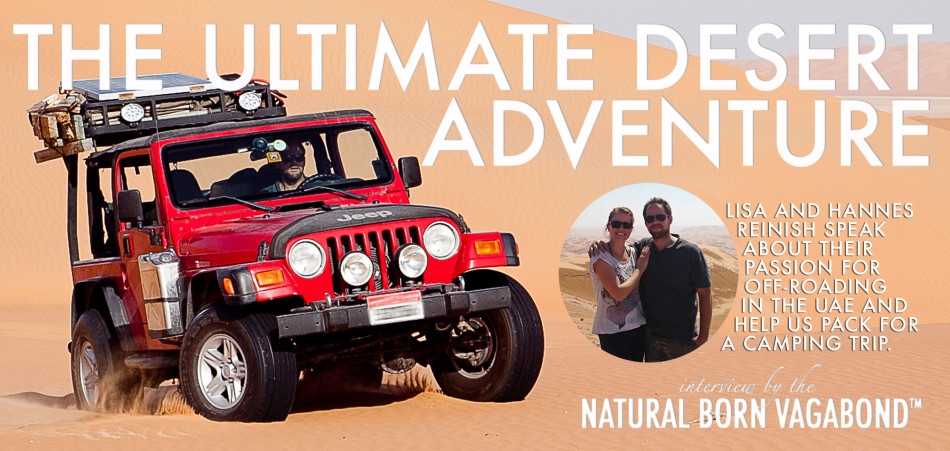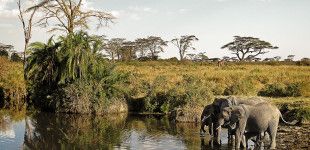Welcome travelers!
Natural Born Vagabond™ is a bilingual (English and Polish) site devoted to travel photography and journalism. Here you can find images and articles from our remote travels. The ambition of the creators is to share the best stories with those who crave wilderness and adventure. If you would like to share your opinions or travel stories please contact us via e-mail.
Featured
Natural Born Vagabond™
Off-roading in the UAE

Desert adventures with Lisa and Hannes Reinisch
NBV speaks to desert troupers Lisa and Hannes Reinish, who spend a good deal of their free time traversing the vast dunes of the Rub Al-Khali (Empty Quarter) desert in the UAE. We ask them about their experiences, most memorable stories and advice on safety and gear.
How did your passion for off-roading start? How long have you been off-roading?
Lisa: Hannes has always been a bit of a boy scout, but for the two of us it really started on our honeymoon, a month-long self-drive safari through Namibia and Botswana. Once we moved to the UAE, back in 2009, we immediately fell in love with the vast open space and peaceful beauty of the desert. We also loved the fact that you can camp and drive pretty much anywhere you want, as long as you respect local customs and the environment. In the beginning we were extremely careful and did not venture far. Hannes drove all kinds of off-road vehicles in the Austrian army (there is compulsory military service where we come from), so he already knew how to drive in difficult terrain – although on snow and mud, not sandy dunes!
How often do you go to the desert and how long do you stay there? Do you travel mostly by yourself or tag along with friends?
Lisa: In the cooler months, we probably head out around twice a month, normally for two days (one overnight trip) – although if it were up to Hannes, we would be out there every weekend! Since 2009, we have done over 60 trips in the UAE and Oman. We usually go with friends; it is just more fun as a group and having another car is better for safety.
What is your favourite route in the region and why?
Hannes: That would probably be crossing the Liwa Desert – about 140 km of beautiful dunes between the western end of the tarmac of the Liwa Oasis and Hameem on the eastern side. I have done it twice with friends and it was an exceptional adventure each time. Lisa: I love the Hajar Mountains, so I would say Snake Canyon in Oman – it offers a great combination of mountain driving and canyoning – swimming, hiking, climbing, abseiling, all in one trip. The Hatta Pools is also always a treat.
Could you tell us about your most memorable adventure?
Hannes: We have taken part in three desert-navigation challenges organised by the Abu Dhabi 4×4 Club, all of which were pretty thrilling. On the last one, we even made second place.
Lisa: A certain recent gourmet camping trip to Liwa was also very special – foodie friends cooking up a five-star dinner is not an extravagance you normally get out there!
We saw you in action on some of the highest dunes in the UAE. While everyone else got stuck in the sand you were “flying” over the hills. Is it practice that makes perfect or maybe the right vehicle does the magic?
Hannes: The vehicle makes a big difference, as do the right tires. But most decent 4x4s will do very well if driven with a bit of skill and care – I did not feel as comfortable at the start – but hours of driving, digging or hiking to seek rescue made for a good school. Confidence is key, but not too much. Once we got the equipment to get us out if we got stuck, I found it much easier and a bit of digging or helping friends who get stuck just becomes part of the adventure – without the stress or fear of being ‘lost’. The Jeep did make a big difference nevertheless; it is just very hard to get stuck with it.
You have an amazing, fully customized vehicle (Jeep Wrangler). We admired your customisations. You have solar panels, air compressor, kitchen with running water, very clever self-made canopy sun awning based on telescopic fishing rods, BBQ grill, all packed to a relatively small car. Could you elaborate a bit on some of those inventions or maybe share some of your secrets for the desert vehicle improvements?
Hannes: Well, thanks, very flattering! It is a project and one that is as much fun to work on as it is to drive it. It is a 2001 Wrangler Sport, often called the “TJ” amongst Jeep-people, with a manual transmission. I lifted it for extra ground clearance and suspension and fitted a set of Sumitomo Desert Tires that are very popular in the UAE and unstoppable on the sand, nicknamed “Shaheen”– the local name for the peregrine falcon also cruising the desert.
My own custom ideas include the solar system – it powers the radio, fridge, shower and charges phones and the iPad needed for navigation. It is version 2.0 of a design I fitted on an older car (the VW Touareg) years ago and works very well. You can keep your food and drinks cold and the music running all night long without draining the battery. (And should you forget to turn your lights off and the car will not start, you can jumpstart yourself from the solar battery.)
The roof rack is a custom design too – mainly to have some more storage space in the car for multi-day trips. A company called “Omar’s Steelworks” in Musaffah made it from a pencil drawing I mocked up (see below). It allows me to open the soft-top and ride it like a convertible, which no standard market rack does.

Jeep Wrangler: Essential off-roading upgrades by Hannes
The canopy was an idea that worked out better than expected: Two fishing rods and a bit of fabric offer ample shade and zip up into a tiny bag fitted to the roof rack. (“Oasis Tents” off Salaam Street on 11th Street in Abu Dhabi is where I got all the bags and awnings made.)
I also fitted a compressor under the hood, which allows me to re-inflate the tires to road-pressure once out of the desert with a simple switch. A bit of digging in Musaffah’s Tools and Machinery Store got me there for under 400 dirhams. My mate, Chad, is chief engineering officer on many projects where I do not have the technical confidence.
Another addition is the ‘kitchen’ – a gas-hob and kitchen-sink for that cup of tea and fried eggs in the morning (this item was an Ikea shelf in a previous life).
All of these follow the idea that they must be practical, sturdy and cheap – there is so much you can do yourself with a bit of time on your hands.
Can you give a piece of advice to a novice who is just about to start a desert adventure?
Lisa: Do not go out alone. Go as far and as fast as you feel comfortable, but take it step by step – better to ease into desert driving slowly than frustrating the journey with a dented bumper, annoyed passengers or worse. Go with friends who have gone off-roading before and who seek the adventure. But do not feel challenged to ‘perform’ – it is not a competition. Also, generally, it is always a good idea to read up on where you plan to travel before you venture out – books we have found extremely useful are Dariush Zandi’s “Off-Road in the Emirates” (I and II – What’s on Guides) and for more advanced adventures (but including great driving and vehicle instructions for beginners), Mike Nott’s excellent “Off-Road Adventures UAE and Oman”.
Hannes: Get comfortable with your car, inflating and deflating tires, 4-wheel drive modes and recovery – know how to get yourself unstuck and bring the kit to do it. Respect your surroundings. The desert environment is a harsh climate, yet also a sensitive ecosystem. Bring enough food and water to look after yourself and look after the environment – do not drive over plants; drive extremely carefully around camels; and do not ever leave any waste behind. Avoid plastic – think of waste-reduction when you go shopping and you will soon find that with smart packaging, paper cups and plates, etc. you can reduce the amount of waste by burning these items at campfire (and avoid a ton of plastic waste). Wooden chopsticks make excellent skewers and great kindling for a fire in the morning.
What, in your opinion, is the most important thing to remember when it comes to safety in the desert? Any dangers out there?
Lisa: Wear shoes when it gets dark (to avoid scorpion bites); wear a hat when the sun is up (to avoid sunburns); and do not wear down your car just because there is no speed limit. Look out for each other and communicate (with the other vehicles in your party) – a set of radios from Dragonmart (a shopping centre in Dubai) is a good way to spend 200 dirhams.
Hannes: Find your way in and out – i.e. bring a GPS. Every smartphone has one, but get (download) your maps before you go as there might not be a signal in the desert (MotionXGPS on the iPhone and iPad works wonders for me). If you can, have a look at the area you plan on visiting on Google Earth or similar beforehand – the amazing high resolution images from these platforms will give you a feel for where you are going.
Any exciting plans for future excursions?
Hannes: We will have a go at the “Tropic of Cancer” challenge proposed by a friend (Mike Nott) – we did parts of it this year (2014) and are keenly looking forward to the full adventure next season (2015). Another ‘first’ will the crossing of the Wahiba Sands in Oman – mountains, dunes and the sea all in one trip (we call these “surf and turf” trips ☺).
Could you also tell us a little bit about yourself? Where are you from and what do you do in the UAE?
Lisa: I work for a newspaper in Dubai and my team is mostly involved in publishing books and supplements. We cover a broad range of topics: culture, design, history, art, architecture, food, etc.
Hannes: I work in sustainability and renewable energy – as an advisor to government and companies in the region. We are both from Austria and sometimes miss our family and friends – but luckily many of them have come to visit the UAE and seen the desert with us.

Some of the highest dunes in the UAE. Liwa desert off-roading.
Lisa and Hannes help us pack for the desert. Here is the ultimate packing list for any off-roading adventure:
- 4×4 with a full tank of petrol
- Water (min 5L/person/day) and food supplies
- Sand ladders, tow rope
- Shovel
- GPS (can be smartphone/tablet) and a map for general orientation
- Radio: walkie-talkie or CBS (not a must)
- Fully-charged mobile phone and car chargers
- Tent
- Sleeping mats, chairs, etc.
- BBQ kit and/or dry wood and fire starter
- Flashlights/head torches
- UV protective clothes and comfortable shoes with covered toes
- Solar panels – not a must, but a great comfort and safety factor out there – and very affordable these days
- First aid kit
- Sunblock
- Parasol, canopy or something else to give you shade
- Camera
- Good company
Author’s note: Interview answers by Lisa and Hannes were edited for brevity and clarity.















